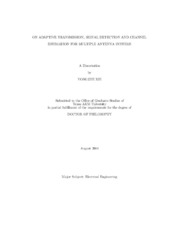| dc.description.abstract | This research concerns analysis of system capacity, development of adaptive transmission schemes with known channel state information at the transmitter (CSIT) and design of new signal detection and channel estimation schemes with low complexity in some multiple antenna systems. We first analyze the sum-rate capacity of the downlink of a cellular system with multiple transmit antennas and multiple receive antennas assuming perfect CSIT. We evaluate the ergodic sum-rate capacity and show how the sum-rate capacity increases as the number of users and the number of receive antennas increases. We develop upper and lower bounds on the sum-rate capacity and study various adaptive MIMO schemes to achieve, or approach, the sum-rate capacity. Next, we study the minimum outage probability transmission schemes in a multiple-input-single-output (MISO) flat fading channel assuming partial CSIT. Considering two special cases: the mean feedback and the covariance feedback, we derive the optimum spatial transmission directions and show that the associated optimum power allocation scheme, which minimizes the outage probability, is closely related to the target rate and the accuracy of the CSIT. Since CSIT is obtained at the cost of feedback bandwidth, we also consider optimal allocation of bandwidth between the data channel and the feedback channel in order to maximize the average throughput of the data channel in MISO, flat fading, frequency division duplex (FDD) systems. We show that beamforming based on feedback CSI can achieve an average rate larger than the capacity without CSIT under a wide range of mobility conditions. We next study a SAGE-aided List-BLAST detection scheme for MIMO systems which can achieve performance close to that of the maximum-likelihood detector with low complexity. Finally, we apply the EM and SAGE algorithms in channel estimation for OFDM systems with multiple transmit antennas and compare them with a recently proposed least-squares based estimation algorithm. The EM and SAGE algorithms partition the problem of estimating a multi-input channel into independent channel estimation for each transmit-receive antenna pair, therefore avoiding the matrix inversion encountered in the joint least-squares estimation. | en |


